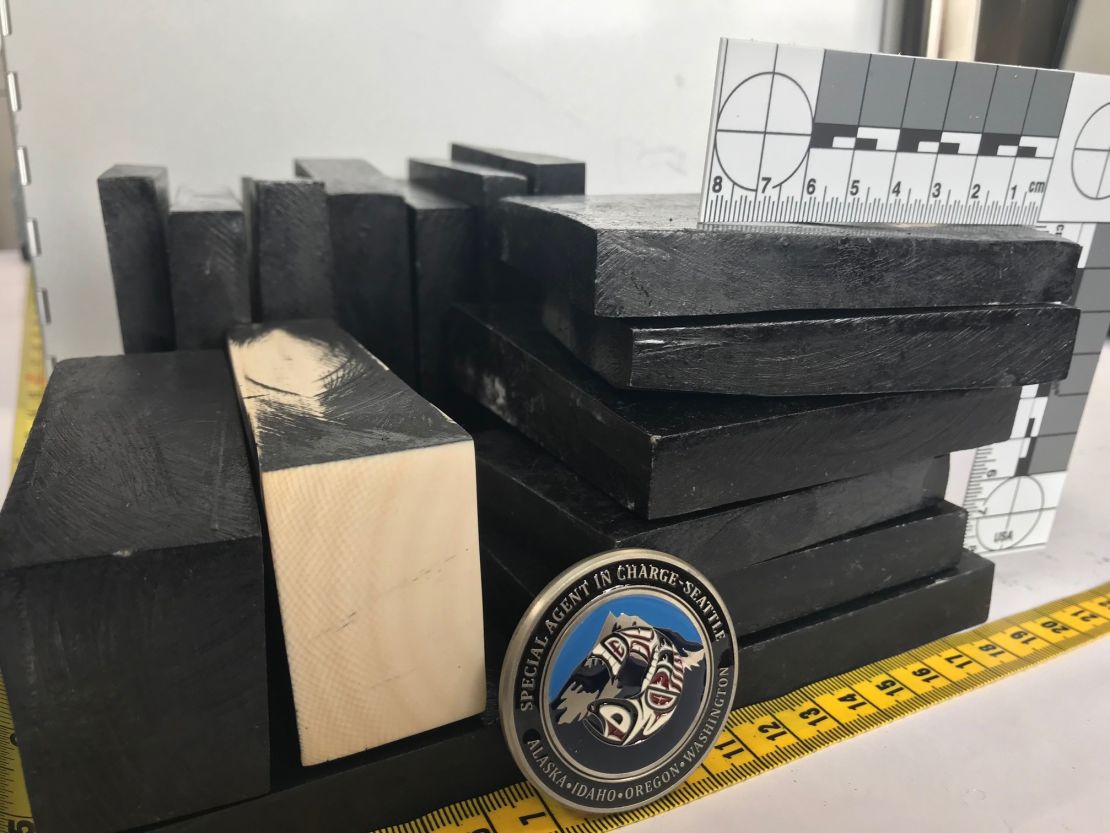DNA evidence helped authorities in the United States and the Democratic Republic of Congo (DRC) seize more than a ton of illegal elephant ivory, rhinoceros horn and pangolin scales in a multimillion dollar trafficking bust.
Two men were arrested last week in Edmonds, Washington, near Seattle, and indicted by a federal grand jury for conspiracy, money laundering, smuggling and Lacey Act violations for trafficking elephant ivory and white rhinoceros horn from the Congo to Seattle, according to a news release from the Justice Department.
The men, who are from the Congo, are accused of working with a middleman to smuggle three packages containing 49 pounds of elephant ivory into the US by airfreight last year and a fourth shipment in May that contained about five pounds of rhinoceros horn, the statement said.
A buyer paid $14,500 for the ivory and $18,000 for the horn, the DOJ said. The men also sold 55 pounds of pangolin scales which are used for medicinal purposes in some parts of the world, but did not ship them, the statement said.
Following their arrest, a task force in the Congo seized 2,067 pounds of ivory and 75 pounds of pangolin scales in Kinshasa worth approximately $3.5 million, the DOJ said.
Special Agent in Charge Robert Hammer, who oversees Homeland Security Investigations (HSI) operations in the Pacific Northwest told CNN that DNA analysis conducted at the University of Washington helped investigators uncover this operation.
HSI is the principal investigative arm of the US Department of Homeland Security and was the lead agency in this investigation.
Hammer said they have been working with the school for more than a decade.

Sam Wasser, the co-executive director of the Center for Environmental Forensic Science (CEFS) at the University of Washington, told CNN that data collected from a previous seizure in Africa helped lead to the arrests.
His lab developed a method for extracting DNA from ivory and analyzing it to determine where the elephants came from. They’ve also been able to get DNA from elephant dung and used that data to create a reference map of different elephant populations in Africa.
“Wildlife populations are separated over space and time and these separated populations accumulate mutations that make them more distinctive from one another, and highly traceable,” Wasser said.
That helps investigators determine where the poached ivory comes from, he said.
“We can now tell from a DNA sample where an elephant sample came from, from anywhere in Africa, within 180 miles of its origin,” Wasser said.
The center has built up the largest DNA database of seized ivory in the world, with data from 70 seized shipments of a half-ton or more.
“Through analysis conducted by CEFS of the DNA collected during these missions, we are able to identify DNA matches between multiple seizures that otherwise would not have been connected,” Hammer said in an email.
Wasser said they’ve found that ivory from individual elephants, such as a left and right tusk, is sometimes seized in separate shipments.
“Whenever that happened, those two seizures always were shipped out of the same port, close in time, and all of the ivory – when we looked at the origin – was highly in overlap, which suggests it was the same transnational criminal organization (TCO) moving both shipments,” Wasser said.
Being able to connect the different shipments has helped investigators map the criminal groups’ activities and work with other countries to stop them.
“This multinational collaborative effort dismantles and disrupts these TCOs where they operate, facilitates prosecutions by host country governments, and provides a road map for HSI to conduct financial investigations into these TCOs and seize their illicit assets acquired through their criminal activity,” Hammer said.
That can also prevent other crimes, Wasser said, because the people smuggling endangered animal parts will also ship drugs, weapons, people and other contraband.
The ivory shipped to the United States in this bust had been cut into smaller pieces, painted black, and then mixed in with a shipment of ebony wood in hopes of avoiding detection, according to authorities.
The suspects were arrested on November 3 when they came to the US to allegedly negotiate a larger sale of more than two tons of elephant ivory, a ton of pangolin scales and multiple intact rhinoceros horns, the statement said.
If convicted, they face a maximum of 20 years imprisonment for the smuggling and money laundering charges and five years for the conspiracy and Lacey Act violations, the Justice Department said.





